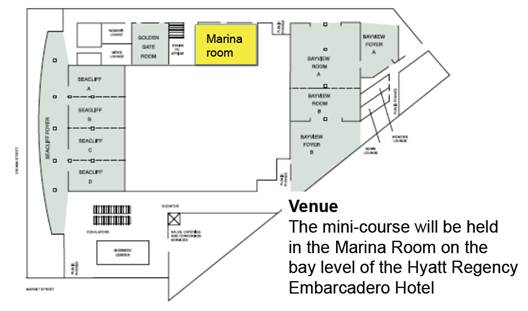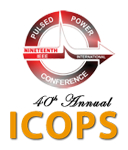Mini-course:
Aspects of High Energy Density Physics
Sat., June 15 and Sun., June 16, 2013
Marina Room, Hyatt Regency Embarcadero Hotel
Click Here for Mini-Course Flyer!
Description of the Course:
High Energy Density (HED) physics refers to the study of matter at energy densities near 100 billion Joules per cubic meter, which corresponds to a pressure of approximately 1 Megabar. High energy lasers, short pulse lasers, and pulsed power generators, as well as advanced diagnostics, have enabled recent and rapid growth in the field of HED physics. Furthermore this exciting research moves forward in a number of directions, at both University and National Laboratory settings.
This mini-course is designed for graduate students and active scientists working in the field. The lectures will provide an overall view of the fundamental  physics, experiments, and diagnostics used to study HED matter. The first day begins with the HED physics of Inertial Confinement Fusion (ICF), including X-ray spectroscopy of the implosion dynamics. Large scale testbeds of ICF HED physics include the National Ignition Facility (NIF) at Lawrence Livermore National Laboratory and the Omega laser at the Laboratory for Laser Energetics. Experiments at these facilities can bring the dynamics of the cosmos into the lab, and are discussed in a lecture on Laboratory Astrophysics.
physics, experiments, and diagnostics used to study HED matter. The first day begins with the HED physics of Inertial Confinement Fusion (ICF), including X-ray spectroscopy of the implosion dynamics. Large scale testbeds of ICF HED physics include the National Ignition Facility (NIF) at Lawrence Livermore National Laboratory and the Omega laser at the Laboratory for Laser Energetics. Experiments at these facilities can bring the dynamics of the cosmos into the lab, and are discussed in a lecture on Laboratory Astrophysics.
Further presentations continue with the laser generation of HED plasmas (HEDP), but with very different parameters for the laser pulse. The formation of energetic beams by short pulse, high intensity lasers will be discussed through experiments and simulations. When matter is rapidly heated by a laser and before it can expand, it is too hot to apply condensed mater physics and too dense to be a weakly coupled plasma. This Warm Dense Matter (WDM) regime is discussed at the quantum level in the last lecture of the first day.
The second day concentrates on plasmas produced with pulsed power generators that use electrical current to compress ordinary matter into the HED state. Experiments on large scale generators, such as the Z machine at Sandia National Laboratories, as well as University scale systems, such as at Cornell University, are presented. Spectroscopic diagnostics are essential to reveal the nature of such plasmas and recent advances in this area are described in the third lecture of the day. The final presentation includes a history and presents recent experiments and theory of HEDP formed when the generator current compresses matter embedded with the flux of an ambient magnetic field.
Mini-course Agenda – Topics & Instructors:
Saturday, June 15, 2013
8:00 – 8:30 am
Welcome & Introductory Remarks
John Giuliani (Naval Research Laboratory)
8:30 – 9:30 am
Hydrodynamics of HED ICF
Ricardo Betti (Univ. of Rochester)
9:30 – 10:30 am
X-Ray Spectroscopy for ICF Implosions
Roberto Mancini (Univ. Nevada, Reno)
10:30 – 11:00 am
break with refreshments
11:00 am – 12:00 pm
HED Experiments on the NIF
James Hammer (Lawrence Livermore National Laboratory)
12:00 – 1:00 pm
lunch
1:00 – 2:00 pm
Laboratory Astrophysics
Paul Drake (Univ. of Michigan)
2:00 – 3:00 pm
Intense Particle Beam Generation from Short Pulse
High Intensity Laser-Solid Interactions
Farhat Beg (Univ. of California, San Diego)
3:00 – 3:30 pm
break with refreshments
3:30 – 4:30 pm
Models of Laser-Target Interactions
George Petrov (Naval Research Laboratory)
4:30 – 5:30 pm
Quantum Molecular Dynamics Simulations
for HED Plasmas & WDM
Michael Desjarlais (Sandia National Laboratories)
Sunday, June 16, 2013
8:30 – 9:30 am
HED Physics Experiments on the Z Accelerator
Christine Coverdale (Sandia National Laboratories)
9:30 – 10:30 am
Z-Pinch Experiments on University Scale Machines
Pierre Gourdain (Cornell Univ.)
10:30 – 11:00 am
break with refreshments
11:00 am – 12:00 pm
Spectroscopic Diagnostic Analysis of HED Plasmas
Yitzhak Maron (Weizmann Institute of Science)
12:00 – 1:00 pm
lunch
1:00 – 2:00 pm
Magnetic Flux Compression in HED Plasmas
Alexander Velikovich (Naval Research Laboratory)
2:00 – 3:00 pm
Concluding Remarks
John Giuliani (Naval Research Laboratory)

To register for the mini-course please visit the Conference Registration page
and follow the instructions.
Mini-course Registration Fee
regular $550 (early)……$650 (after 4/26)
student $300 (early)……$350 (after 4/26)
Registration includes lunch and dinner on Saturday, June 15,
and lunch on Sunday, June 16.
NPSS students are encouraged to apply for a Paul Phelps Grant for meeting
the mini-course fee.
mini-course organizer
John L. Giuliani
Plasma Physics Division
Naval Research Laboratory
+1 (202) 767-9299
john.giuliani@nrl.navy.mil
The Paul Phelps Continuing Education Grant
The Paul Phelps Continuing Education Grant is available for attendees to the special mini-course “Aspects of High Energy Density Physics” at the IEEE 2013 Pulsed Power & Plasma Science Conference (PPPS 2013). The 11/2 day course will be offered on June 15-16 at the Hyatt Regency Embarcadero Hotel preceding the PPPS Conference.
This grant was established by the IEEE Nuclear and Plasma Sciences Society (NPSS) to promote continuing education and encourage membership in the NPSS. This award will support at least two outstanding students or unemployed members of the NPSS to attend the mini-course for the purpose of aiding their future career or enabling a career change.
The award will consist of the prepayment of the mini-course registration fee and partial payment of the PPPS Conference fee. No other travel expenses will be reimbursed.
Applicants must be either a Student Member of the IEEE or an unemployed IEEE NPSS member. Information on joining the IEEE as a Student Member or enrolling in NPSS can be found at http://ewh.ieee.org/soc/nps/phelps-award.html. Applicants must submit the form found here to the mini-course organizer at john.giuliani@nrl.navy.mil by May 1, 2012.

